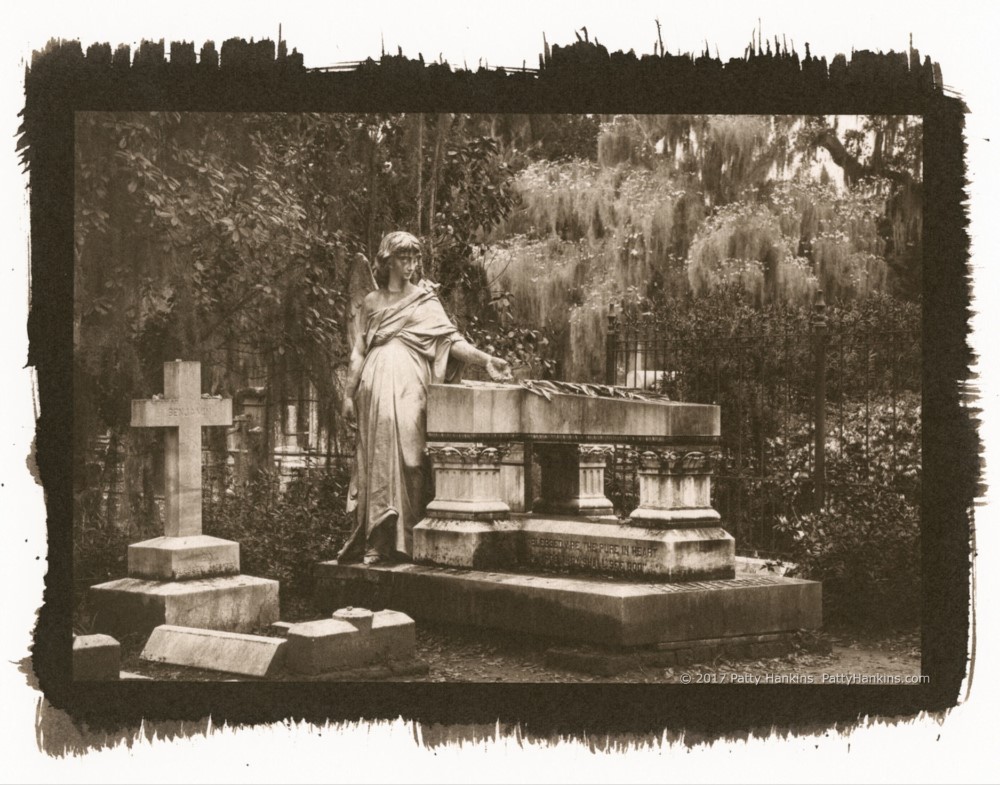
by hankinslawrenceimages | Dec 16, 2017 | Alternative Proceses, Cemeteries, Georgia, Kallitypes

Graveyard Angel, Bonaventure Cemetery, Savannah, Georgia Kallitype © 2017 Patty Hankins
I wanted to share one of the first palladium-toned kallitypes I printed of a graveyard angel at Bonaventure Cemetery in Savannah, Georgia
One of the amazing graveyard angels at Bonaventure Cemetery in Savannah, Georgia.
This photograph is printed using the late 19th-century photographing printing process known as Kallityping. The emulsion is hand-painted onto the paper, exposed with a negative under bright lights, and toned with palladium. Each print from a negative is slightly different – so these are one of a kind images.
The photographs are printed on 8 X 10″ Bergger 100% Cotton Cot 320 paper. They are matted to 11 X 14″ in a white acid-free mat.
This photo is available on my website at https://beautifulflowerpictures.com/store/graveyard-angel-bonaventure-cemetery-savannah-palladium-toned-kallitype-landscape/

by hankinslawrenceimages | Dec 1, 2017 | Alternative Proceses, Kallitypes
There’s something about cemeteries in the South. I don’t know if it’s the Spanish Moss. Or all the Angel statues. Or just that feeling of being in the South. But in the past few years, I seem to be spending more and more time photographing in cemeteries – particularly in the South.

Graveyard Angel, Bonaventure Cemetery, Savannah, Georgia. Palladium Toned Kallitype. © 2017 Patty Hankins
My cemetery photography started on my first trip to Bonaventure Cemetery in Savannah and has led me to cemeteries in places like Hartford, Connecticut, Albany, New York, Washington, DC, Richmond, Virginia, Charleston, South Carolina, and of course, New Orleans, Louisiana. And as I photographed, I kept learning more and more about the rural cemetery movement in the mid-nineteenth century and why these magnificent cemeteries were where they are, and why they have the statuary I’m fascinated with.

Grave Lined Path, Unitarian Cemetery, Charleston, South Carolina. Palladium Toned Kallitype © 2017 Patty Hankins
But there was just something about my photos I wasn’t happy with. The printed color images just seemed too modern. I tried printing them as black and white photos, but they still weren’t right. Recently, Bill and I have started printing photographs as kallitypes – a late nineteenth-century photography process. And suddenly I was happy with my photos and realized that I’d figure out how I wanted to print them!

Graveyard Angel, Bonaventure Cemetery, Savannah, Georgia. Palladium Toned Kallitype. © 2017 Patty Hankins
Kallitypes are a contact printing process where I create black and white image from my color photograph, invert it to create a negative image, print the negative image on a film transparency – so I end up with a digital negative I can use for printing contact prints. We then coat the paper with a mixture of silver nitrate and ferric oxalate on a sheet of cotton rag paper and expose the negative and the treated paper to bright lights. Once the paper is exposed, we develop it in a chemical solution and tone them with palladium to get the final image. Each image made with the same negative is slightly different from any other since the emulsion never goes down exactly the same way, and the developing and toning is a little different each time.

Gracie Watson Grave, Bonaventure Cemetery, Savannah, Georgia. Palladium Toned Kallitype. © 2017 Patty Hankins
I end up with a one-of-a-kind printed photograph usually taken in a cemetery established in the nineteenth-century using a nineteenth-century photographing printing process. And I get to photograph all those wonderful graveyard angels. Talk about the way to make a historian, a photographer and a Doctor Who fan extremely happy!

Graveyard Angel, Hollywood Cemetery, Richmond, Virginia. Palladium Toned Kallitype. © 2017 Patty Hankins
I’ve been getting a great response to the images as I’ve shared them on social media. So I’ve decided to offer them as one-of-a-kind photographs on my website. You can see the ones that are currently available at https://beautifulflowerpictures.com/store/kallitypes-2/

If you’d like to see my kallitypes in person, there are several framed kallitypes on exhibit (and available for sale) at HairLab Studio, 1701 Rockville Pike, Suite B20 #6, Rockville, Maryland. I’d like to thank Marty Thompson of HairLab Studio for giving me the opportunity to display my kallitypes at his salon.
I hope you’ve enjoyed seeing my latest photographic adventures. Don’t forget to check out all the kallitypes on my website at https://beautifulflowerpictures.com/store/kallitypes-2/
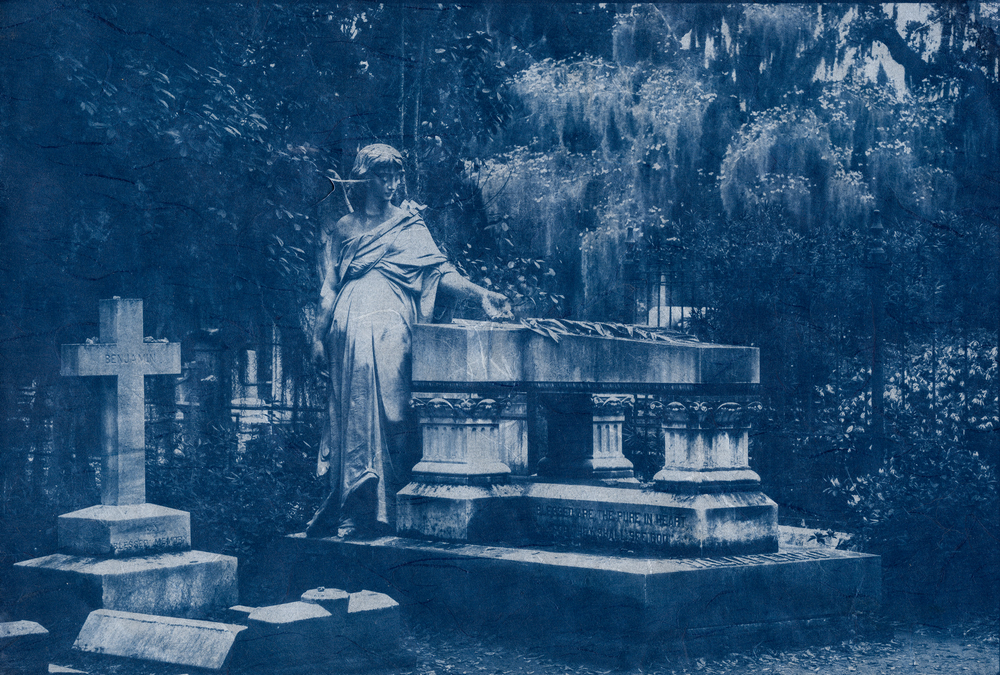
by hankinslawrenceimages | Jul 7, 2017 | Alternative Proceses, Cyanotypes, Workshops
For the past couple of years, Bill and I have been experimenting with some historic photographic printing techniques. So far my favorites are cyanotypes and kallitypes. For both processes, you apply a mix of chemicals to paper, put a negative over the paper, expose them with UV light and then develop them in either water or a chemical mixture.
Cyanotyping is the process developed in the 1840s that results in photographs in shades of blue. Sir John Hershel discovered the process in 1842 as a way to duplicate notes and diagrams. For decades, architects used the process Hershel developed to print blueprints. Within a year of Hershel discovery of the process, Anna Atkins created the first photograms by laying plants over sheets of treated paper. She published the first book of photographs, Photographs of British Algae: Cyanotype Impressions in 1843. Once 19th-century photographers started using large format negatives, it became fairly easy to print multiple copies of photographs as cyanotypes. These days, photographers can transform and print their images as digital negatives to make cyanotypes.
Here are a few of my photographs printed as cyanotypes. Some of my favorite photographs to print as cyanotypes are ones I’ve taken in cemeteries.
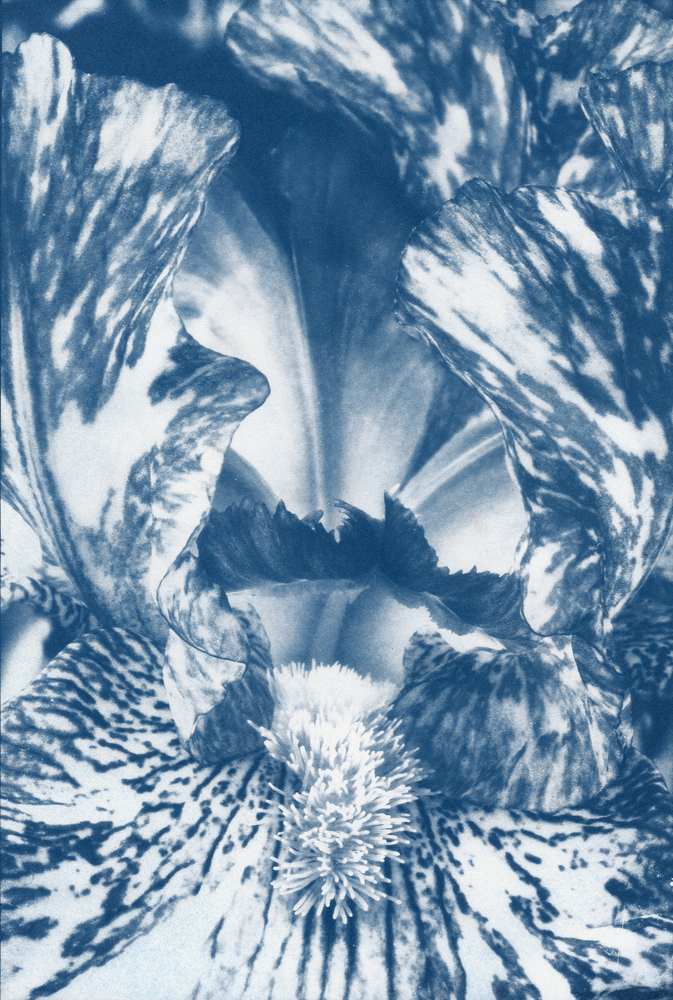
Purple Streaker Iris Cyanotype © 2017 Patty Hankins

Graveyard Angel Cyanotype © 2017 Patty Hankins

In the Cemetery Cyanotype © 2017 Patty Hankins
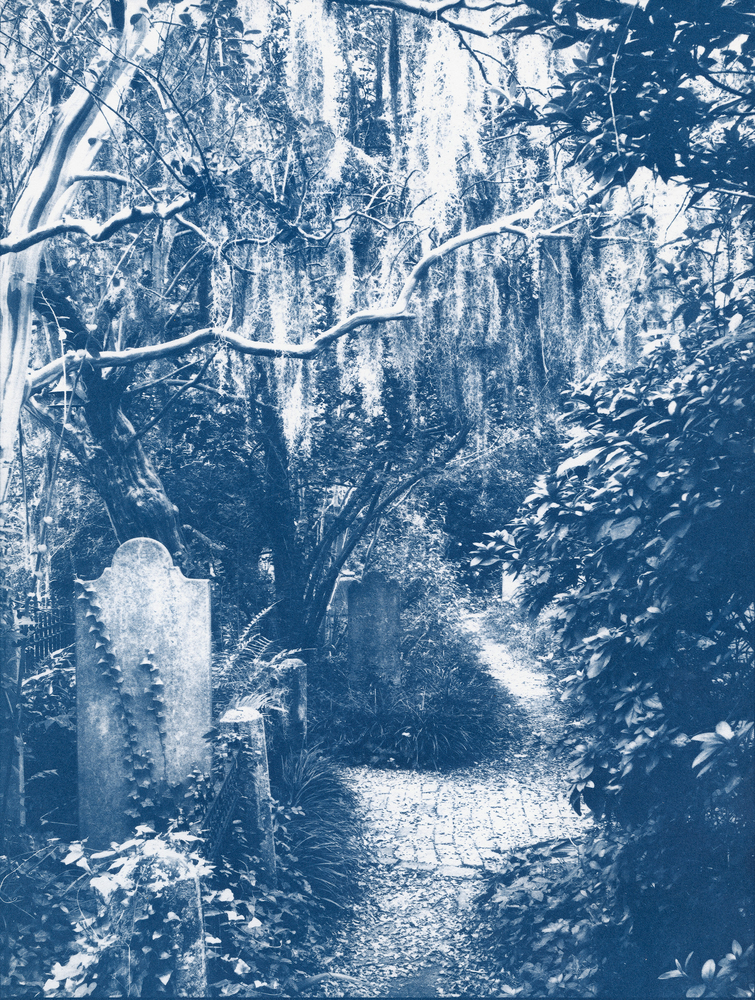
In the Cemetery Cyanotype © 2017 Patty Hankins
I’m also experimenting with creating graphic designs that I can print as cyanotypes. Here’s an image that started as a label on a wine bottled that I manipulated in Photoshop and then printed as a cyanotype.
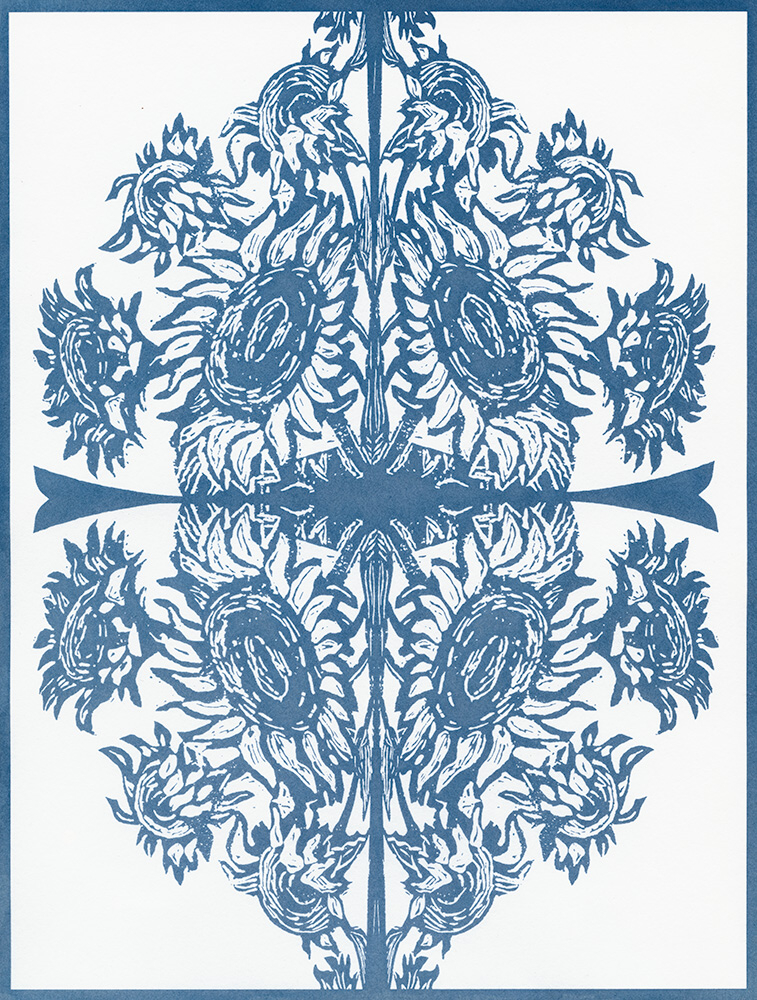
Sunflower Graphic Cyanotype © 2017 Patty Hankins
Cyanotyping is one of the easiest historic photographic printing processes to learn. The chemicals (ammonium iron(III) citrate and potassium ferricyanide) used to treat the paper are very safe to use. And you literally develop cyanotypes in water.
If you’d like to learn more about cyanotyping, Bill and I will be teaching an Introduction to Cyanotyping on August 26. We’ll provide all the supplies and tools you need, all you’ll need to bring is a couple of digital image files and a sense of fun.
You can learn more about our Introduction to Cyanotyping workshop on my website at http://beautifulflowerpictures.com/introduction-to-cyanotyping/
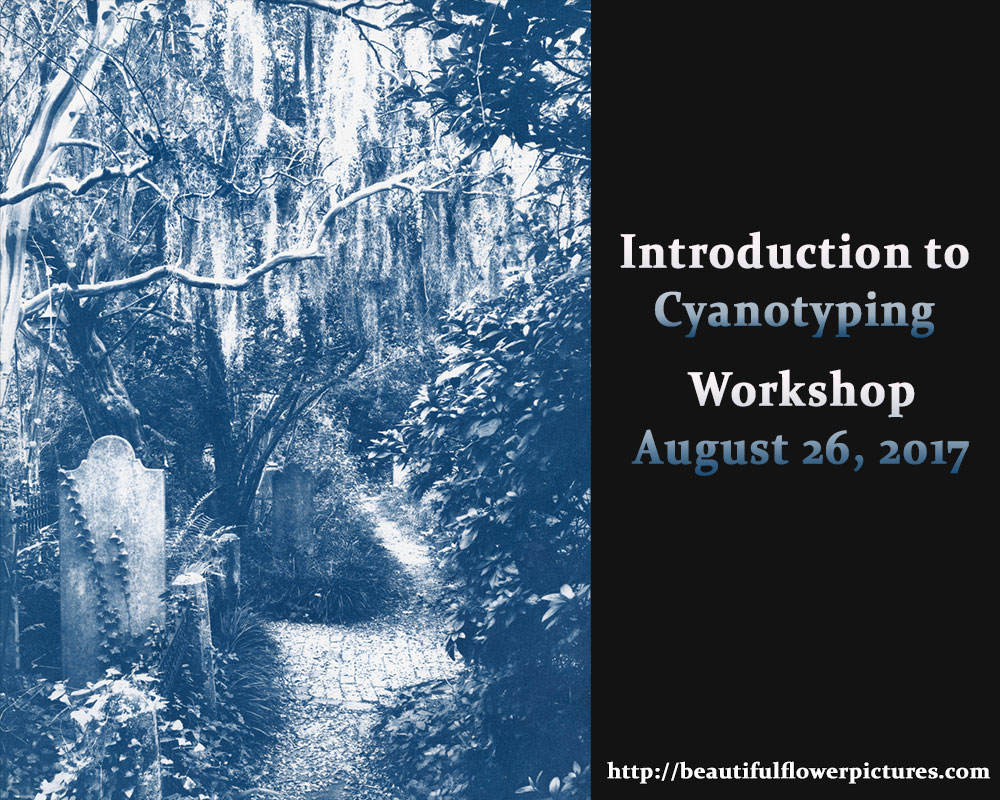
We’d love to have you join us for the workshop.















